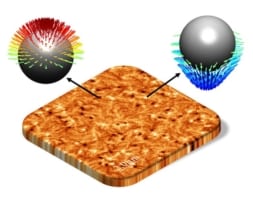
Researchers at Nanjing University in China have succeeded in fabricating the first 3D pseudospin-valley coupled acoustic topological insulator. The structure is made up of layers of acoustic topological pseudospin-valley coupled “saddle” surface states that greatly reduce backscattering of sound waves – something that could be useful for making sound filters and sensor devices. The work could also help advance the emerging field of acoustic pseudospintronics.
Sound scatters from most material surfaces and creates echoes that can not only be distracting to listeners but also reduce the efficiency of devices like sound filters and hearing aids. The new 3D topological acoustic crystals made by a team led by Ming-Hui Lu and Yan-Feng Chen could help overcome this problem by transmitting sound in certain directions without much backscattering.
Acoustic version of a topological insulator
Topological insulators are materials that are electrical insulators in the bulk but can conduct electricity on their surface via special surface electronic edge states in which electrons cannot backscatter for topological reasons. Researchers have recently started to look at making an acoustic version of a topological insulator from a phononic (or sonic) crystal – the acoustic equivalent of a photonic crystal.
Just as the periodic variation of the refractive index in a photonic crystal means that only certain wavelengths of light are able to pass through it, a periodic variation in the acoustic properties of a phononic crystal means that only phonons with frequencies outside the phononic band gap can propagate. Such crystals are made by embedding cylinders of one material in a different background medium, with the properties of the phononic band gap depending on the size and periodicity of the cylinders. Sound waves travel on the surface of these crystals but not through their bulk.
Lu and colleagues’ new 3D phononic topological crystals are made of stacked double-layer honeycomb lattices containing two kinds of phononic “atoms” in each layer. Each of these atoms is created from a triangular prism resonant cavity with five interconnecting tubes.
Saddle surface states
The researchers constructed a four-fold degenerate point in the band structure of the stacked layers by first splitting them into two two-fold degenerate layers. They then used certain phonon states (the Bloch states) present in the energy bands to couple the pseudospins on the atoms in the structure. “Our crystal has a screw symmetry and its band structure can be changed so that it goes from being a 2D topological insulator to a 3D one by rotating it and then stacking it in different directions (see above image),” says study lead author Cheng He.
“The way the 2D surface states disperse resembles a saddle shape and, in our work, we construct the surface states using two opposite saddle surfaces.”

Weyl phononic crystal negatively refracts sound waves
Calculations and experiments by the researchers reveal that sound waves at frequencies between 18 to 22 kHz move easily across any defects, disorders and bends on the lattice and do not backscatter very much. This is analogous to the behaviour of electric conductivity on the surface of a topological insulator.
Opposite pseudospins propagate in opposite directions
“The most important property of such acoustic surface states is their robustness to backscattering from bends and defects,” says He. “By studying the acoustic pseudospin-momentum dependent propagating behaviour in the crystal lattice, we found that this behaviour comes from the fact that opposite pseudospins propagate in opposite directions.”
The researchers, reporting their work in Nature Communications 10.1038/s41467-018-07030-2, say that reduced sound wave backscattering in these 2D surface states might be used to make improved sound filter and sensor devices, such hearing aids that channel sound more efficiently through the ear canal. They might also be used to study acoustic pseudospintronics, which resembles spintronics except that it exploits pseudopsins on phonons (created artificially by changing the lattice symmetry in a phononic crystal) rather than (intrinsic) electronic spins. “Indeed, we plan to use acoustic pseudospins to design prototype devices,” He tells Physics World.



